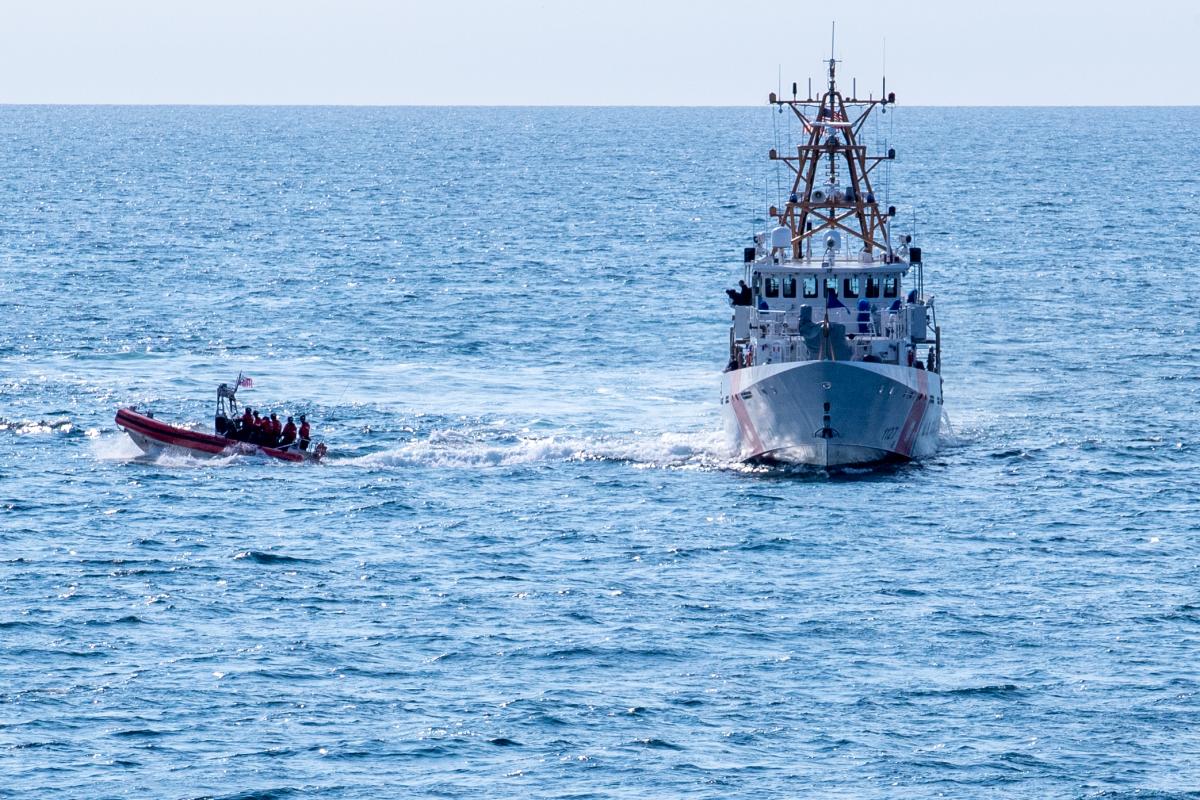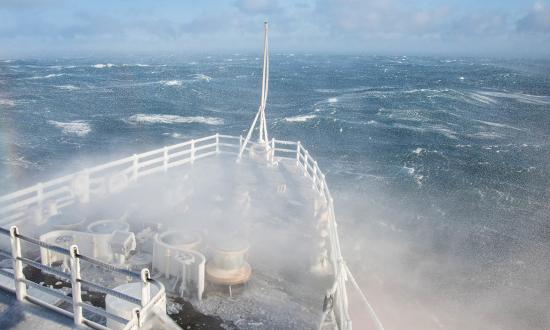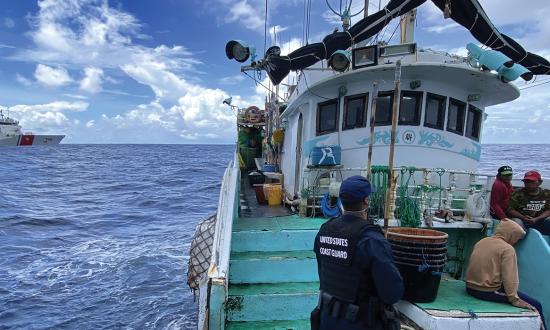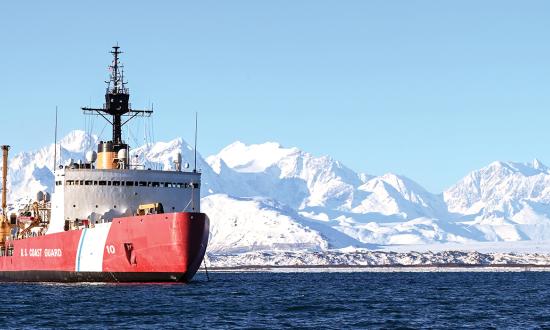The dull thrum of the ship’s machinery and electronics suddenly stops, the eldritch cry of a ship in trouble: silence. Emergency power sputters back online, the ship’s electronics with it, sighing in relief as their fans kick on. On the bridge and the combat information center, radios key but they remain stubbornly mute. No one can transmit or receive a signal off the ship. The crew and the captain are truly alone.
While this vignette reads like a far-fetched scenario from 2034, the reality of contested communications environments and increasingly powerful cyberwarfare tools signal a paradigm shift for the U.S. military and its Sea Services. Denied, degraded, intermittent, limited (DDIL) information environments will be the rule, not the exception. War games in the summer of 2021 highlighted how dire this situation may become. In this exercise, the United States lost network access immediately. In an increasingly fractious maritime security environment, it is a matter of when, not if, U.S. maritime forces will be called on to operate alone and unafraid.
There is plenty the Sea Services can do to bolster resilience across the electromagnetic spectrum and incorporate redundancies into their C5I infrastructure. However, the single most important thing the U.S. Navy can do to prepare for the radio-silent environment awaiting it has nothing to do with technology. The Sea Services need to focus on cultivating seasoned leaders ready to step into uncertain environments with aplomb. The single best way to develop leaders capable of doing so is early command. When contrasted with the United States’ chief strategic competitor, the People’s Republic of China (PRC) and their People’s Liberation Army Navy (PLAN), the United States’ ability to produce experienced commanders operating under the doctrine of mission command will bolster critical asymmetric advantages over the PLAN’s rigid command structure. Early command opportunities are not just a sound method of developing capable senior naval officers, but an obvious strategic imperative.
Competing Command-and-Control Architectures
PLAN
Given the trajectory of its naval ambitions, the PLAN’s rigid “control and command” structure is likely to come under increasing strain given the independence and greater operational tempo required by power projection operations. In late 2020, the RAND Corporation published a study highlighting many of these challenges. A few that stood out:
- PLA military doctrine emphasizes what some have dubbed “control and command,” because of the intrusive oversight in the PLAN. This stems from a culture of risk aversion, unquestioning submission to higher command, and distrust for subordinate commands.
- Until the 1990s, the PLAN functioned as a supporting element of the PLA. It has had limited time to develop an independent service culture attuned to the realities of command and operations at sea in which command and control (C2) is significantly less centralized.
- The PLA and, by default, PLAN, are fundamentally arms of the Chinese Communist Party. Military leaders exercise total conformance to the party on all matters, frequently at the expense of operational flexibility. Chinese military leaders refer to the gap in capability this has created as the “Two Incompatibles,” emphasizing the PLA’s inability to effectively modernize and acquire the capabilities necessary to fight a modern war and undertake the operations it is expected to execute.
The PLAN’s limited experience in projecting power beyond the first and second island chains has provided few opportunities to exercise naval operations, let alone complex ones, without active, constant communications with higher echelons. It is undeniable that the PLAN has made strides in its ability to project power over the last decade. However, the PLAN lacks a comparable timeframe of global operations. To illustrate: A PLAN destroyer first circumnavigated the globe in 2002, while the USS Vincennes completed the U.S. Navy’s first circumnavigation in 1830. Further, given the nature of China’s geography, its maritime interests have primarily existed directly off its coasts. Distant operations and the challenges they bring have never existed as operational imperatives in the way they have for the U.S. Navy, which has been required to execute complex missions across oceans since the late 18th century.
Finally, the practical realities of the PLA’s dual political commissar—the PLAN officer command structure—directly implies that all decisions, even at the tactical level, are managed by two potentially competing voices. The political and tactical considerations of any given military operation frequently are placed against each other. In the throes of complex operations and in the absence of a higher arbitrating authority, mistakes, missteps, and failures will naturally abound.
U.S. Navy
In contrast, by 1916 the United States had a Navy that was “second to none,” just 134 years after its inception.1 While illustrative of the gestation period of a global navy, it also demonstrates the significant reservoir of professional tradition the U.S. Navy can draw on in contrast to the PLAN.
Fortunately for the Sea Services, the concept of mission command, where “the conduct of military operations through decentralized execution, based upon mission-type orders,” has grown into prevailing doctrinal concept across the U.S. military. The joint forces have fully embraced the concept, evidenced by professional military education (PME) curricula, promulgated doctrine, and public statements by senior officers. More sophisticated C2 networks herald the modernization of the tools the joint force will use to control the battlespace, prompting concerns of “leadership by blue force tracker.”
While mission command’s doctrinal relevance remains clear, there is a growing school of thought, best represented in Donald Vandergriff’s recent publication, Adopting Mission Command: Developing Leaders for a Superior Command Culture, which emphasizes training practices over technology as superior enablers of the concept. Vandergriff contends that “junior leadership training is the critical component in cementing a successful mission command culture.”2 This notion, in conjunction with the U.S. military’s clear doctrinal and institutional emphasis, begs the question: Where are the practical opportunities to exercise mission command?
When the stark differences between the PLAN and U.S. Navy’s C2 architecture are laid bare, it is clear they have significant implications for the world maritime flashpoints. It is probable that naval forces who are nimble and unflappable in the face of uncertainty and degraded communications will have an upper hand in any future maritime dispute. To cultivate leaders capable of meeting the chaos of DDIL environments, the U.S. Sea Services must emphasize early command.
Implementing Early Command in a Meaningful Way
The best way for the Navy to inculcate a culture of adaptability and confidence among its surface warfare officers is to put them into command roles as early as lieutenants and lieutenant commanders so that when they reach 0-5 command, they have “been there before.” The late, legendary naval tactician Captain Wayne Hughes famously declared “men matter most,” in his six cornerstones of naval warfare.3 Of course, this refers to the training and mental conditioning of a ship’s crew, but it also refers to its leadership. The United States and its Sea Services should use cultural legacies to their advantage; within that heritage is a strong tradition of early command. The Navy must lean on the value of early command to develop leaders who are prepared for the future challenges of contested maritime environments.
Unfortunately, because early command opportunities are scarce in the U.S. Navy and the Mk VI patrol boats are phased out of service, the Navy must reckon with how it will articulate the need for a platform that accommodates early command, beyond simply a platform to help junior officers “command early and command often.”
There is some dialogue that questions the utility of small surface combatants within the framework of today’s fleet architecture. However, in the high-end fight there are missions that a small surface combatant would excel at, especially in the dynamic environment the Navy can expect to encounter in tomorrow’s wars. Small combatants cannot be expected to win decisive sea battles, but history shows they have always been crucial mission enablers across the spectrum of conflict.
Small surface combatants have even more to contribute to the low-end fight. There are myriad missions on which the destroyer captains of tomorrow can cut their teeth, and here the Navy can take a lesson from the U.S. Coast Guard. Coast Guard lieutenants and lieutenant commanders are given wide latitude to execute the counterdrug mission on board cutters. The counterdrug fight could serve as a perfect “training wheels” mission for junior commanding officers to hone their leadership skills and tactical acumen while executing a valuable mission. In the same vein, a substantial aspect of circumventing future conflict in the Indo-Pacific is a strategy that relies on cultivating allies and partnerships.3 The Coast Guard already has made inroads in the region, undertaking capacity building and combatting illegal, unregulated, and unreported (IUU) fishing with Coast Guard lieutenants in the captain’s chair. Here, the Coast Guard can also use the Navy’s help in the form of small Navy ships manned by junior commanding officers.
Taking on these missions might seem a far cry from the high-end fight and unrecognizable to the missions the Navy has carried out in the Arabian Gulf, but they are not without precedent or legal framework. In this instance, the use of smaller surface combatants has the advantage of freeing up capital assets (such as destroyers and littoral combat ships), which have previously partnered with the Coast Guard to conduct the IUU fishing and counter-narcotics mission. Junior commanding officers manning small ships to execute useful and substantive missions is a low-risk, high-yield investment, which will foster operational creativity and independence in tomorrow’s senior officers.
The Navy need only look to the massive success of the Coast Guard’s Sentinel-class cutters, made by Bollinger Shipyards. Colloquially known as fast response cutters (FRCs), the ships could be employed by the Navy as a highly capable, proven, and repeatable platform. The selection of the FRC as the Navy’s small surface combatant would be a boon to interoperability and eroding integration seams in the austere reaches of the Pacific. It would lay the groundwork for a Patrol Forces Indo Pacific, with combined Coast Guard and Navy patrol boats conducting maritime domain awareness missions and cultivating partnerships with allies throughout the region.
In addition, the FRC also offers the Marine Corps an additional nimble platform from which to execute effective expeditionary advanced base operations (EABO). The FRC also offers junior commanding officers the opportunity to really “drive the ship.” The platform’s agility and mission set lends itself to honing staples of maritime proficiency, such as high-speed intercept and maneuver, forces acting on ships, and mooring and unmooring. Often, junior officers in the Navy do not get sufficient repetitions for special ship-handling evolutions, and these important concepts are left in the abstract. This is an unacceptable knowledge gap, considering the challenges that face the United States and its Navy in the near term. Clearly, early command can be packaged and sold beyond “leadership development.”
Two converging realities demand that early command be a strategic imperative for the Sea Services. First, ubiquitous DDIL information environments will force the Sea Services to operate alone and unafraid for extended periods of time. Second, the PRC has emerged as the United States’ chief strategic competitor—one with a burgeoning naval apparatus with a radically different “control and command” construct. To compete and succeed in this environment, the United States must take every advantage it can get. This starts with the Navy providing junior command opportunities early and often to breed the senior leaders of tomorrow who will be at home in a degraded and austere environment. These seasoned leaders will be a distinct asymmetric advantage. Developing them is a manifest strategic imperative.






